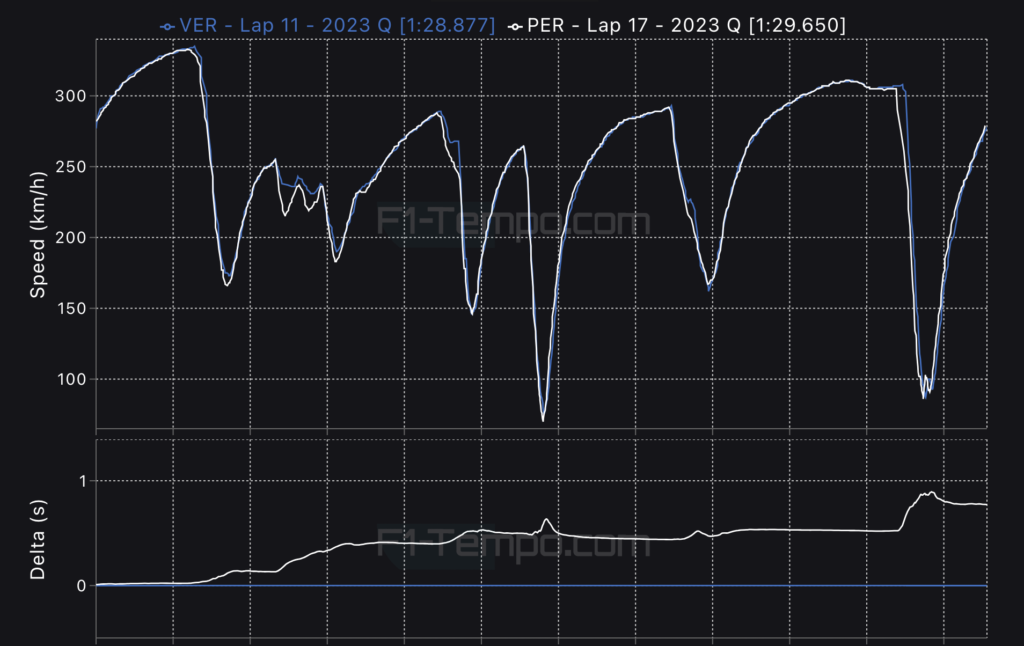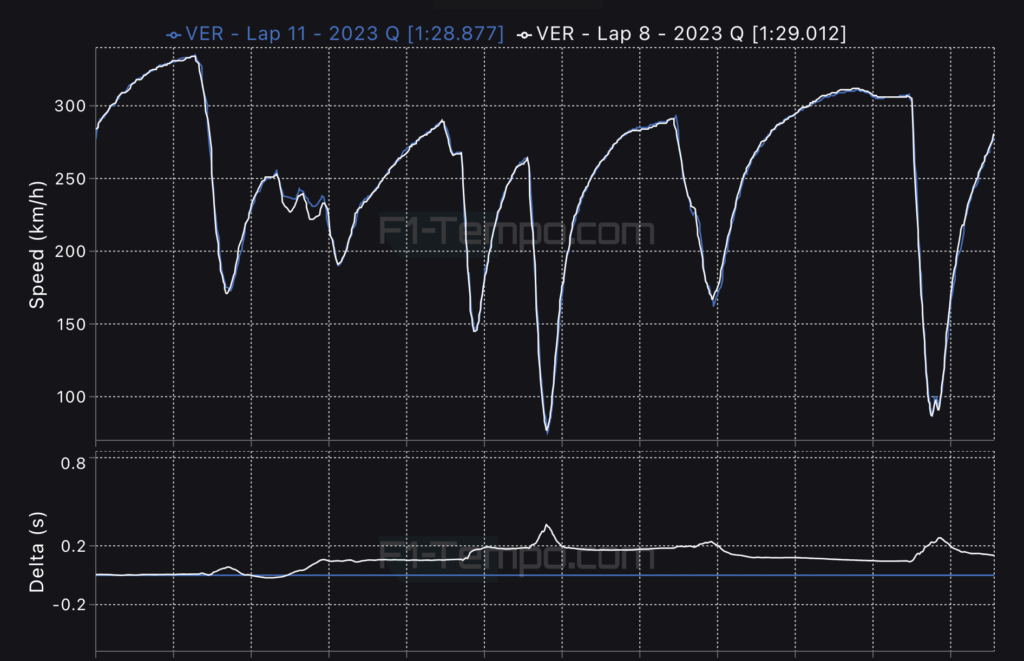
Japanese GP this year might be the last chance to enjoy the autumn Suzuka since it will be held in spring from next year. Suzuka is well known as a driver’s circuit and the development of the weekend literally suited its reputation. In this article, we will look back at the fierce battles of each team and driver with data.
1. Verstappen’s overwhelming qualifying performance
Verstappen took pole position with a 0.581 second gap to second-placed Piastri. He also had a 0.773 second gap to his teammate Perez, and it may be more appropriate to say that the Red Bull’s dominance is due to the tenths of a second that Verstappen creates, rather than the Red Bull machine being overwhelming.
First of all, let’s take a look at Verstappen’s pole lap onboard footage from F1’s official YouTube video.
Max Verstappen’s Mighty Pole Lap | 2023 Japanese Grand Prix | Pirelli
Next, Fig.1 shows the telemetry data of Verstappen (blue) and Perez (white) in Q3 best lap.

The upper part is speed and the lower part is time difference. Looking at this, you can see that Verstappen steadily pulls away from Perez from turn 1 to turn 6. The same goes for 8 and 9. Especially in turn 4,5 and 8,9, there is a clear and apparently visible speed difference.
Looking at the time difference, Perez’s graph does not go down even for a moment until the first Degner. This means that Verstappen had utterly no disadvantage against his teammate in this section, which makes Suzuka a driver’s circuit.
The only place where Perez slightly closed the gap was at the turn 11, where he caught up by about 0.05 seconds until turn 13. Even if you look at Verstappen’s onboard footage, he was not very smooth at the turn 11 as he stopped turning the steering wheel for a moment at the entrance of the corner, and then turned it more afterwards.
And then Verstappen was slightly faster again at turn 13 and 14, and widened his lead significantly at the turn16 and 17.
Here, let’s compare Verstappen’s first (white) and second (blue) attacks in Q3.

Verstappen’s final attack carried much more speed in the S-curve section than his first attack in Q3. He also gained more time in the turn 8 and 9, but he should have overdriven at the entrance of the turn 14 and lost some time on the exit, but he gained again at the chicane.
In this way, Verstappen improved his time by refining the details from his first attack. The Suzuka circuit, especially the S-curve and turn 8 and 9, has a characteristic that makes it very difficult to improve your time by attacking more. In such a situation, being able to drive like this is probably what makes Verstappen Verstappen.
Well, let’s also touch on the race briefly. Fig.3 shows the race pace of Verstappen and McLaren drivers.

The first stint was everything again this time. Norris was able to keep up with Verstappen with a pace difference of about 0.3 seconds in the early part of the stint, but Verstappen had less degradation and gradually increased the pace difference to Norris. And from the second stint onwards, he seemed to be controlling his pace looking behind him.
The Red Bull team was hit by an unexpected slump in Singapore, but this time Perez was beaten by McLaren and Ferrari in qualifying, and his race was also messy, so I’m guessing we can’t say they are fully recovered. But even so, Verstappen won with a runaway victory on one of the world’s best driver’s circuits.
Since Perez is also second in the driver’s ranking, it is not fair to say that Red Bull’s machine is slow. But it was certainly a Japanese GP that suggested that Verstappen’s presence is pushing up the Red Bull team several levels.
2. Was Sainz’s strategy reasonable?
What I was curious about this time was Sainz’s strategy. Ferrari easily let Hamilton undercut Sainz on his second pit stop, stayed out to create a tyre offset and caught up with him at the end of the race but failed to overtake him, and finished sixth.
Here we will analyze this strategy of not covering Hamilton on the next lap. Fig.4 shows the race pace of Hamilton and Sainz.

First of all, on lap 34, just before Hamilton went into the pit, the gap between the two was 3.3 seconds.
And looking at Fig.4, Hamilton’s second lap of his third stint was almost 3 seconds faster than the lap time of end part Sainz’s 2nd stint. If his outlap was even more explosive, there was a possibility that he would not be able to cover him even if he reacted the next lap. If Ferrari had simulated this number beforehand, there would be some validity in the idea of staying out and creating a tyre offset.
On the other hand, Hamilton’s pit stop time was 3.0 seconds, which was a bit long, and his outlap was not that fast either. In fact, when he reached turn 13, the gap between them was 24 seconds, and if we assume that the pit loss was 22 seconds, he had a margin of 2 seconds. And considering that there are only two complex corners, turn 13,14 and 16,17, in this section, and that the tyre difference is less likely to show up, it should have been possible for Sainz to conclude that he could box here and stay ahead.
(By the way, the reason why we chose turn 13 as the comparison point is because it is the last point where Hamilton passes by when Sainz has to decide whether to enter the pit or not before the chicane.)
Taking these into account, Ferrari is a team that aims for the championship from next year onwards. In that case, wouldn’t it have been better to have some spirit to tell Sainz to “push like hell!” on the straight of lap 35 and send him out with a 2.1-second pit stop and keep him ahead? Especially here is Suzuka, where it is hard to overtake.
At least to me, Ferrari’s strategy this time seemed too conservative, even if it was not as bad as last year’s Monaco.
3. Another high-speed circuit in two weeks
This Japanese GP was a race full of highlights, such as Verstappen’s impressive drive, Red Bull’s constructors’ title decision, McLaren’s strong performance, Tsunoda’s Q3 appearance and so on.
But the season is not over yet. In two weeks’ time, it will be the Qatar GP. It is not as undulating as Suzuka, but the speed range of the corners is quite high, and it has a similar characteristic to Zandvoort or Suzuka. Therefore, Verstappen will once again pull away from the rest of the field, and McLaren will be the closest contender for the podium. Mercedes, Ferrari, Alpine and Perez, Alonso and others are also expected to have very close pace.
How will each team and driver surprise us with the data from Suzuka? Will Verstappen’s driver’s title be decided here? It looks like it will be another exciting GP.
Writer: Takumi